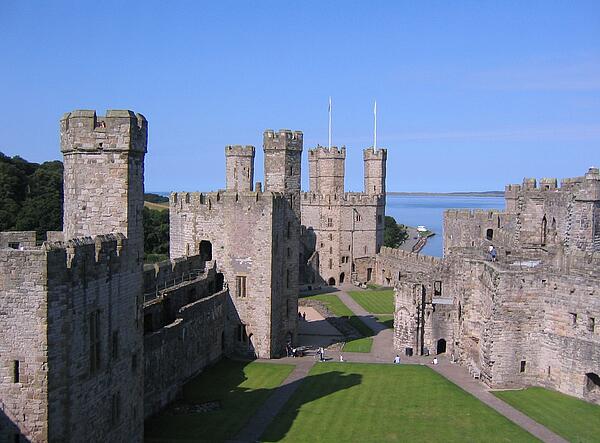Concentric Castles
After stone keep castles, concentric castles became popular in England. This occurred during the reign of Edward I and they are mainly associated with north-west Wales, where many were built. The most famous concentric castles include Harleck, Beaumaris, Caernarfon and Conwy.
While stone keep castles were square and based around a central keep, concentric castles had no ‘strong’ point and were instead considered to be secure the whole way round. Each of these castles did have a strongly defended entrance point though, and the core of the castle was defended by a series of curtain walls. The furthest of these would have been the shortest to allow defenders to spot an enemy as they approached. Similarly, the curtain wall closest to the edge of the castle would have been longest to give those defending the castle the greatest height advantage over their enemy.
Some of the towers constructed within concentric castles were round rather than square. This is the case in both Beaumaris and Caernarfon. Making the towers round made it hard for the enemy to dig underneath in an attempt to topple the towers (sapping) and many engineers of the time felt they were also stronger than their square counterparts. Caernarfon Castle even had towers built within its towers, which made them an incredibly strong defence.

While considered strong, concentric castles did have two major weaknesses: They were incredibly expensive to build and they made it hard for troops to engage from a safe position. This latter weakness would mean, should the enemy choose to avoid the castle, that troops would have to decide between saying where they were and ignoring the battle or moving into open ground. However, many concentric castles were in such strategic areas that enemies were forced to engage.
All of the concentric castles built by Edward I were built by the sea, making it easy for them to resupply via ship. This also removed another form of attack, as the castle could not be besieged.
Caernarfon is considered to be one of the best examples of a concentric castle as the walls are actually two walls with a hollow middle filled with rubble. The rubble did put extra pressure on the walls, but this just forced the architects and engineers to ensure the blocks of stone were very large and strong.
When the castle was finished it had cost the king around £27,000, the equivalent ion around £35 million in modern terms and roughly his entire annual income.This highlights the importance Edward placed on the castle.
This figure was even more significant when we take into account the £100,000 Edward had already spent on the wars against the Welsh, so taxes were raised to cover these funds.
Detailed records were kept by Edward for all of the castles he constructed, including Caernarfon, Harlech and Conway. Between them, these castles cost Edward £50,000, which was a significant sum considering the average skilled worker at the time was earning between 3p and 4p per day.
Caernarfon and the other castles based in the northern parts of Wales were all designed by Master James of St George, who was an architect from Savoy. It is thought that he would have met Edward as the king returned from the Crusades.
Edward passed away in 1307, with Master James dying just two years later. The two deaths of such significant forces in castle construction, the building of fortifications in England began to slip. By 1327, castle building in Wales had completely ended, never to be continued. Instead, subsequent kings chose to build more cost effective palaces.
See also:
MLA Citation/Reference
"Concentric Castles". HistoryLearning.com. 2025. Web.
